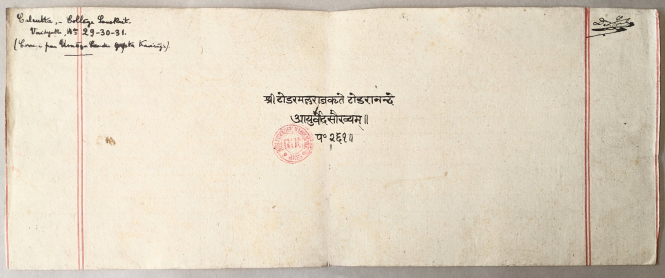Ever since his doctoral thesis on Indian medicine, Palmyr Uldéric Alexis Cordier (1871-1914) was determined to travel to India himself to study Āyurvedic texts in their original Sanskrit.
Life and death in the colonial medical corps
Trained as a doctor in the French colonial medical corps, he was initially posted to Senegal and then to Madagascar, where he suffered from the very same tropical maladies that he was learning to treat. But even during those periods, he continued his study of Sanskrit as well as Tibetan, since many important Sanskrit texts are only extant in their Tibetan translations.
Finally, in 1898, he obtained a post in Chandernagor, a French colony in Bengal, near Calcutta. Although he spent just over two years there, working at the hospital, he managed to travel all over north India and collected copies of hundreds of manuscripts. In 1901, he was posted to Pondicherry, where he continued his research, cataloguing the medical manuscripts in the Government Oriental Manuscripts Library in Chennai (now held at the Anna Centenary Library). Based on all of these materials, he published a long, ground-breaking article in Le Muséon which is still an invaluable reference work today, over a hundred years later.
Unfortunately, Cordier did not live long enough to make full use of the materials that he had collected; when the First World War broke out, he was taken prisoner in Alsace and interrogated. Although he was promptly released, he died only a few days later, in his home in Besançon. And for two decades after his death, the handful of articles that he had published were all that remained of his scholarly output. It wasn’t until 1932 that Jean Filliozat found and recognized Cordier’s manuscript collection at an antiquarian bookseller in Paris and, with the help of Sylvain Lévi, petitioned the BnF to purchase the whole lot. Today, Cordier’s manuscripts are split between the Chinois, Indien, Sanscrit, and Tibétain collections.

Figure 1: Cordier's signature in the top right corner in Yogaśataka (Source : Sanscrit 1256 , Département des Manuscrits, Bibliothèque nationale de France.)
The Cordier collection rediscovered
The value of what Cordier had collected is immeasurable. When Filliozat completed his survey of the collection, he published the list of manuscripts in the Journal asiatique. Many of these manuscripts are transcriptions — sometimes in Cordier’s own hand — of rare and important works. Cordier had an interesting method: for some especially important manuscripts, he first took photographs of the manu-script and then made a transcript from those photographs. In his meticulous notes, he records that he used Wratten & Wainwright plates, and printed on Kodak Eastman paper. Among these photographic plates and prints, now preserved at the BnF, are photographs of an old Nepalese manuscript of the Kāśyapasaṃhitā, a major work on Āyurveda. Only two fragmentary manuscripts of this text have ever been found; the Nepalese manuscript, that Cordier photographed, is now lost.
While Cordier’s collection is a vital resource on ancient Indian medicine, it is also full information about Indian scholars at the turn of the century. Although Cordier would sometimes copy out manuscripts himself, at other times he employed skilled Sanskrit pandits to transcribe them. The transcript of the Kāśyapasaṃhitā, for example, was begun by Cordier, but on page 5, a different hand takes over, and at the end of the manuscript, this scribe gives his name in the colophon — Kavirāja Umeśacandra, an expert on Āyurveda, who also proofread the work of other scribes. There are other scribes for whom we have less information — like Prohita Dīnānātha, who copied many manuscripts from Bikaner, Kesampath Kumara Chakravarthi, from Madras, or Dhannālāla Śarmā, who worked under Gaṅgādhāra Jośī in Alwar — but through their scribal colophons, paired with Cordier’s detailed notes, we can begin to piece together some of the intellectual networks that propelled Sanskrit scholarship in modern India.

Figure 2: Āyurvedasaukhya, 1r. Cordier's signature is on the top right corner. In the top left corner, he has written, "Corrigé par Umēça Candra Gupta Kavirāja." (Source : Sanscrit 1171 , Département des Manuscrits, Bibliothèque nationale de France.)
Hidden treasures of the Bengali Renaissance
Since Cordier specialized in Indian medicine, his collection of medical manuscripts have naturally received the most attention. But it seems that he also collected over a hundred manuscripts on non-medical subjects, most of which have lain unnoticed since Filliozat surveyed them. For example, Sanscrit 1438, a single palm-leaf folio that Filliozat had not identified, is a fragment of the famous Aṣṭasāhasrikā Prajñāpāramitā; this Buddhist manuscript may date as far back as the 11th century. Sanscrit 1442.2, another fragment probably dating to the 12th century, is so far the oldest known witness of the Vahnipurāṇa, a text that was only recently edited from a few, relatively recent manuscripts.
Although we know very little about how or why Cordier acquired these manuscripts, there are some patterns that can be discerned. Apart from some very old Sanskrit fragments, assorted Tibetan dharaṇis, and some miscellanea in other languages, most of the non-medical manuscripts are from Bengal, dating to the 18th or 19th centuries, and they give us an incredible window into what scholars have called the Bengali Renaissance. Here, again, the scribal colophons are full of the names of the luminaries of this period — Mṛtyuñjaya Vidyālaṅkāra, head paṇḍit of Fort William College; Śivaprasāda Śarmā, who may have tutored Ram Mohan Roy; Rādhākānta Tarkavāgīśa, who worked with Sir William Jones; and Haraprasāda Śāstrī, who lent Cordier a number of manuscripts and is also one of the most famous Bengali scholars of the late 19th / early 20th century. Though it has largely gone unnoticed, Cordier has, through his collection, inadvertently given us an intellectual history of modern Bengal.

Figure 3: Vivādārṇavasetu, 128r. Rādhākānta Tarkavāgīśa's colophon is on the last line. (Source : Sanscrit 1406 , Département des Manuscrits, Bibliothèque nationale de France.)
Published in April 2024
.png)



